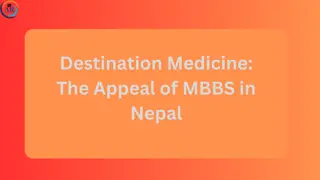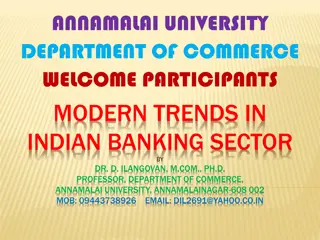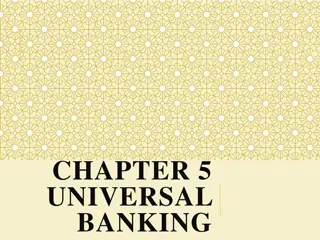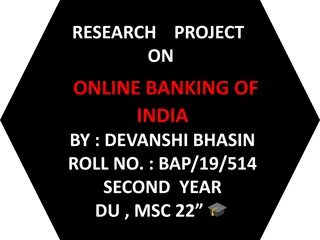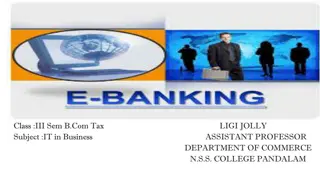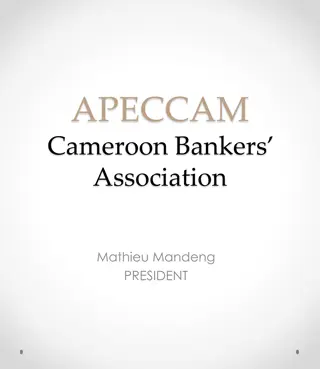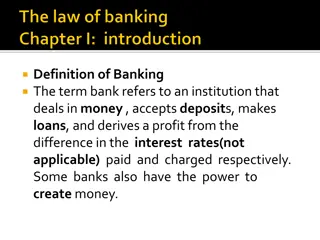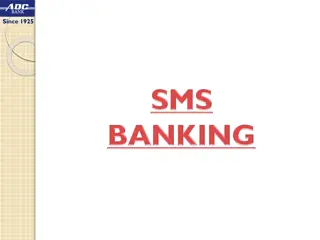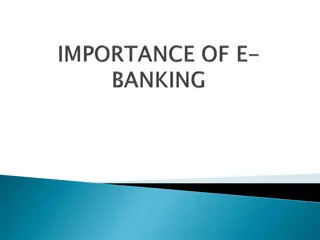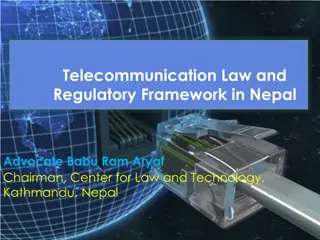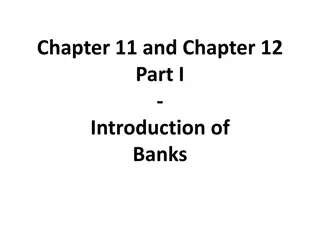Understanding E-Banking: Formation, Evolution, and Regulations in Nepal
E-banking has revolutionized the banking sector, allowing customers to conduct financial transactions conveniently. This article explores the history, ways of e-banking, total number of BFIs in Nepal, bank accounts in the country, and policy provisions related to electronic banking services. It also highlights the formation of skilled users in e-banking and the measures taken to protect financial customers and enhance financial literacy in Nepal.
Download Presentation

Please find below an Image/Link to download the presentation.
The content on the website is provided AS IS for your information and personal use only. It may not be sold, licensed, or shared on other websites without obtaining consent from the author. Download presentation by click this link. If you encounter any issues during the download, it is possible that the publisher has removed the file from their server.
E N D
Presentation Transcript
FORMATION OF SKILLED USERS IN E-BANKING GROUP 5 BIKASH THAPA, BISHWAS REGMI, NIKITA SHRESTHA, NIRAJ SHRESTHA, SURENDRA TIWARI
INTRODUCTION E-banking is a service provided by a Bank or other financial institutions that allows its customers to conduct financial transaction/services through internet. E-banking has changed the traditional banking method.
WAYS OF E-BANKING Automated Teller Machines (ATM) Point of Sales (PoS) Telephone Banking (Tele Banking) Internet Banking Mobile Banking (SMS Banking) Smart Cards
HISTORY NABIL was the first bank to start Credit Card in early 1990( JV). Himalayan Bank introduced Automated Teller machine (ATM) in 1995 and tele banking which Started from 1997. Kumari Bank first introduced SMS banking in 2002 and Internet banking was first introduced by Laxmi bank in 2004.
TOTAL NUMBER OF BFIS IN NEPAL Commercial Banks Development Banks Finance Companies Micro Credits 28 33 24 57 Total 157
NUMBER OF BANK ACCOUNTS IN THE COUNTRY Class A Class B Class C 20978261 4127818 552308 Total 25658387 *as of Push 2075
POLICY PROVISION 1. Directives no. 20/075 : About Electronic Banking Services. Branchless Banking : Terms, Conditions, Minimum Requirements, Contract between Bank and Customers, Reporting 2. Directives no. 21/075 : Provision related to Protection of Financial Customer and Financial Literacy - Should give information about accounts, Fees, Procedure, Procedure on different kinds of electronic Cards
3Directives no. 5/075 : Limit on Electronic Transactions Prepaid Card : 1 lakh (Nepal 25 Thousand-Day, 50 Thousand Month) David Card: 25 Thousand- Per Transaction, 1 lakh-Day Mobile Banking : 5000- Per Transaction, 15 Thousand- Day, 50 Thousand- Month Internet Banking : 1 Lakh - Day, 10 Lakh- Month E- Wallet : 5000- Per Transaction, 15 Thousand- Day, 25 Thousand- Month
NUMBER OF MOBILE BANKING CUSTOMER IN NEPAL Year Class A Class B Class C Total 2075 5866531 509897 18488 6394916 2074 3198198 314926 17103 3530227 2073 2050354 174389 11331 2236074
NUMBER OF INTERNET BANKING CUSTOMER IN NEPAL Year Class A Class B Class C Total 2075 835293 17444 3958 856695 2074 825097 14638 2696 842431 2073 544008 18219 1901 564128
INTERNET USERS IN NEPAL 368610 2357660 12789497 Fixed Broadband(wired) Mobile Broadband Fixed Broadband(wireless)
WHO IS LEFT OUT ? Out of total, 71.74% person people having bank accounts still don t take e banking service. Out of total, 53.26% person using broadband internet don t use e banking.
CHALLENGES - SKILLED USERS IN E-BANKING Infrastructure Transaction Limitations Perception Towards Banking Risk Linguistic/Lite racy Factor Management/ Operability
SOLUTIONS Digital Literacy ICT awareness Campaigns Financial Literacy Policy Amendment Simple and easily usable UI Academic Syllabus reformation
OUTCOMES Paperless Operation Cashless Transaction Minimizing operation cost Time saving Quality in Service
EMAIL US ON bishwasregmi51@gmail.com nirajshrestha315@gmail.com nikshres522@gmail.com lex.suren@gmail.com advocatebikashthapa@gmail.com





